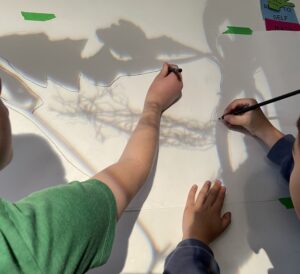As an educator, I believe in providing an environment that catalyzes children’s innate curiosity and presents opportunities for experiential learning. Children have the capacity and the right to be researchers of the world, and through an interdisciplinary approach, I view the classroom as laboratory, studio, stage, garden, and library for collective inquiry.

S. Dunn, Curricular links to science (PL3.1) through drawing and projection, 2025
Play, curiosity, material explorations, and relationships are all important generative modes that allow children to understand their world and make meaning. Play is a foundation of innovative thought and as children become more mature thinkers – these creative instincts are important to maintain. As children get older, their capacity for divergent thinking, to generate multiple solutions and ideas to a problem, declines (Robinson, 2010). As Nadia Bynoe and Angelique Thompson note, play-based learning stimulates “critical thinking, problem solving, communication, and collaboration” (Bynoe & Thompson, 2023, p. 14). Play, creative languages, and engagement with community and environment are fuel for learning and growth.
I believe the classroom environment must be responsive and dynamic. It is shaped by the children themselves – reflecting their paths of inquiry, the investigations they choose to follow, and their needs as learners (both physically, cognitively, and emotionally). When children have a hand in shaping their learning space, they are given agency as individuals and as a contributor to their school community. This inspires a deeper engagement and joy in learning (Bynoe & Thompson, 2023, p 35).
I believe in a classroom that extends beyond the walls of the school and embraces children’s culture, community, and family. Students are offered opportunities, across the curriculum, to share and explore their cultures. Families are welcomed to contribute to our learning. This may include:
- students bringing questions to encourage discussion at home,
- welcoming family members as classroom guests or during land-based learning
- communication and images sent home to share your child’s learning process,
- families participating in shared meals for cultural learning activities
Community is central to my approach to teaching and learning. Engagement in social justice and collective action, teaches children that their contributions as citizens are important. It teaches them that we all have rights, and that they have responsibility to advocate for themselves and others.
My focus on community includes a commitment to engaged acts of reconciliation. Indigenous Ways of Knowing are woven into both learning and assessment. Narrative, personal reflection, and hands-on experiences are a priority. I value the learning that happens through listening, both to local Indigenous elders and to the land (Thorne, 2019). I often draw from Robin Wall Kimmerer’s beautiful book, Braiding Sweetgrass For Young Adults.
The natural world is a thread I weave throughout the school year. By looking at the larger natural systems and relationships in our world, we can approach our role within it with respect, curiosity, and care. I seek to nourish a culture of reciprocity (Kimmerer, 2022, p 97) – a model for how we engage both in our classroom, as learners, within our family systems, and our community. We will learn about change, growth, and beauty. In nature, stories unfold around us and the possibilities and awe of the outdoor environment (be it park, prairie, or cityscape) ignite children’s desire for discovery. Being offered opportunities to explore our world outside of the classroom activates imagination and the world-building seeds of story creation. By being the authors of their own collective story, they gain agency as citizens within their community (Mackay & Salazar, 2021, p. 13).
“What we want to do is activate within children the desire and will and great pleasure that comes from being the authors of their own learning”
(Malaguzzi, 1994, p.3).
I prioritize creating an ‘identity-safe’ and child-centred classroom (Steele & Cohn-Vargas, 2013,p 19) where children are the authors of their own story. Their personal experiences, knowledge, cultural perspective, curiosity and ideas are acknowledged and given room to shape our collective learning. Our classroom is a community, where each child’s social and cultural identity, their unique abilities and ways of communicating are a foundation for relationship building, personal confidence, and an inclusive mindset. Students’ voices are centred, and THEY tell the story of who they are, in turn building authentic relationships with each other. Together they have a hand in painting the larger image of a world that holds a place for all of them. A place shaped by imagination and identity. A place filled with connection, freedom, and belonging (Mackay & Salazar, 2021, p.15).
References
Bynoe, N. K., & Thompson, A. (2023). The gift of playful learning: A guide for educators. Teacher Created Materials.
Kimmerer, R. W. (2022). Braiding sweetgrass for young adults: Indigenous wisdom, scientific knowledge, and the teachings of plants. The New Press.
MacKay, S. H. & Salazar, K. (2021). Story workshop: New possibilities for young writers. Heinemann.
Malaguzzi, L.(1994). Your image of the child: Where teaching begins. Exchange, 3, 1-5.
Robinson, S.K. (2010). Changing education paradigms [Video]. TED. https://www.ted.com/talks/sir_ken_robinson_changing_education_paradigms
Steele, Dorthy M., & Cohn-Vargas, Becki (2013). Identity Safe Classrooms: Places to Belong and Learn. SAGE Publications.
Thorne, R. (2019, August). Teaching through the four R’s of Indigenous education. Learning Bird. https://learningbird.com/teaching-through-the-four-rs-of-indigenous-education/
